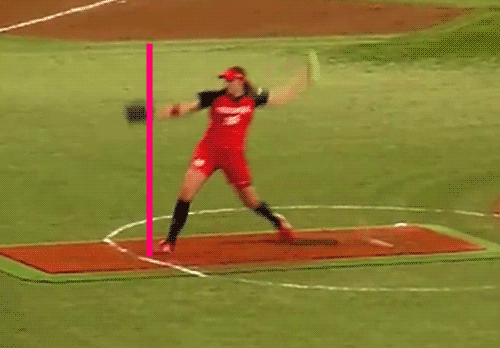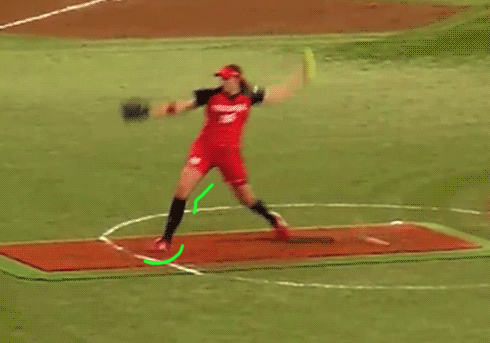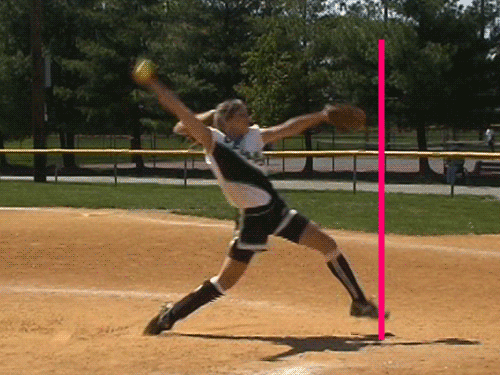Front Side Resistance
We’ve spent a lot of articles talking about the drive through, but the landing leg is really just as important.
What is front side resistance?
When you deliver a windmill pitch, your body is moving forward toward the catcher with a great deal of force. Front side resistance is the ability to stabilize this action using the strength of your front leg. If your front leg is weak, you could lose your balance and/or soften the impact of your release and lose speed. If you have a problem with leaning forward, this is likely one of your issues.
In terms of the physics of pitching, that stabilization via the front leg is what redirects the force of your push off into your arm for delivery. Read this for a more detailed explanation of how pitch velocity is determined.

If you draw a line straight up from your landing foot, your head should ALWAYS be behind that line. Notice how Monica Abbott’s visor doesn’t come near that line until the VERY end, long after the ball is out of her hand. Part of this is landing in a good balanced position in the first place, but after that the front leg must be strong enough to maintain that body posture despite how forcefully the back half of the body is coming through. That front leg must be STRONG.

The leg lands in a very stable position. The foot is firmly on the ground, the knee is at approximately a 45-degree angle to the power line (don’t go getting out your protractors; some variation in this is fine), and the knee is NOT LOCKED.
Take a video of yourself sometime and stop on this frame. Is you knee locked straight? Or is it collapsing inward toward your back leg? Are you collapsing inward onto the instep of the landing foot? All of these things can ruin your front side resistance. Even if you land in roughly this position, weakness in your leg can still cause your resistance to break down as your finish the drive through.
Another important factor in maintaining your front side resistance is making sure your drive through is as linear as possible, like in the animation of Abbott above. If you “slam the door,” or bring your hips around past that front leg before the ball is out of your hand, that will also break your resistance.

Here is a change-up example. For some reason, I find that a lot of pitchers struggle MORE to maintain front side resistance on the change than they do on full speed pitches. If anything, it’s more important on the change. Maintaining excellent front side resistance enables you to release the ball with full motion speed without losing command of the strike zone or adding velocity to the pitch itself.
Carly,
Do you, or have you ever, placed anything in front of the pitcher to give the pitcher a physical visual to drive through as linear as possible, as you call it? Or would you provide any other teaching ideas to help in this? Thanks.
John
I find a physical barrier often leaves them afraid and then they hold back. In some cases, front side resistance and afterwards the drive through break down because the pitcher is trying to stride more aggressively than her body can handle at its current level of strength. When this is the case, I sometimes put something unobtrusive, like tape, on the ground just to give her a reference point. A good rule of thumb is to measure her height and put the tape that distance away from the rubber. Then when she gets her posture and drive under control, she can work up to increasing her stride very gradually.
I love the short break down! Any chance you could do a side by side comparison of Monica vs Cat?
Thanks!
Hi Anna, I found a similar angle so I will post it soon!